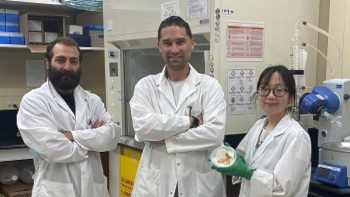For more information
Media Relations
Agriculture and Agri-Food Canada
1-866-345-7972
aafc.mediarelations-relationsmedias.aac@agr.gc.ca
Imagine if you could design a customized crop treatment program that targets the specific pests that are present in your field – with less spraying.
Thanks in part to research by AAFC Research Scientist Dr. Justin Pahara and his team of scientists at the Lethbridge Research and Development Centre, that may soon be a reality.
Dr. Pahara is leading new research in nanotechnology, using tiny particles (called nanoparticles) that bind to agricultural pests without harming beneficial plants and insects. How tiny is tiny? Well, to give an example, they are 1,000 times smaller than the width of a tattoo needle. Sharp!
These microscopic nanoparticles are bound with active ingredients that affect a specific plant or insect, and can be customized to produce a variety of desired outcomes. Applied like traditional pesticides, this next generation of crop protection products are designed to be targeted, effective and efficient so producers can get better protection while spraying less.
The next generation of crop treatments
While nanotechnology may sound futuristic and conjure up images of computers and robots, what this really means is that Dr. Pahara and his team are creating promising new crop treatments that will help Canadian producers remain global leaders in producing healthy, nutritious food to the highest standards.
These cutting-edge crop treatments will enable producers to address the bad pests in their field, while keeping the good species and reducing or eliminating their need to spray with traditional insecticides and herbicides. This could reduce costly crop spraying, while also increasing production and yields.
Nanoparticle crop treatments can also help producers expand their market opportunities internationally and abroad, where local regulations may exclude products treated with traditional insecticides or herbicides.
“Our goal is to create a new generation of crop treatments that help growers manage pests when and where they need to, while maintaining the health of their field, increasing production and empowering them to sell what they grow around the world.”
- Dr. Justin Pahara, Research Scientist, Agriculture and Agri-Food Canada
Expanding nanotechnology
One of the first steps to creating effective nanoparticle crop treatments is to uncover the best delivery particle and active ingredient combinations for the specific species of pest being treated. And with millions of different variations to choose from, much of the early research into these crop treatments used an educated guess and test approach.
This is where Dr. Pahara’s lab comes in. The lab, created about a year ago, has invested in new robotic technology that helps them test different nanoparticle combinations in many species of pests on a large scale. This approach is important because it allows the team to test thousands of options early in the process, and focus their efforts on optimization of the most effective formulations. With this knowledge, new treatments for many different pests can be developed more quickly – setting the stage for researchers to rapidly respond to new threats.
Initial focus and future potential
Dr. Pahara and his team have already made great progress towards their goal of creating a new generation of crop treatments by focusing their attention on common pests that plague many producers: lygus bugs and cutworms. Lygus bugs are perhaps the most widely distributed pest in the world, impacting crops such as alfalfa, canola, sunflowers, beans, buckwheat, strawberries and more
Cutworms are moth larvae that feed on a wide range of crops such as barley, wheat, pulses and cereals, wreaking havoc in fields across Canada.
The team is currently working on a new crop treatment that will target these hard-to-manage pests by treating the insects with nanoparticles, and creating 3-D images that track where within the insect these particles are going. This insight is essential to selecting the most effective nanoparticle and active ingredient combination to target that species, and ensuring that the active ingredients reach the area within the insect where they are most effective.
While the focus at this time is on lygus and cutworms, the same technology can be applied to a wide range of other pests, including other insects and weeds. This early research is setting the stage for Dr. Pahara and his team to not only expand nanoparticle crop treatments to other pests, but also ensure the treatments are safe, effective and can be scaled up to commercial production. This is key to getting these cutting-edge treatments into the hands and fields of producers.
And despite the ground-breaking nature of the research, growers may have access to nanoparticle treatments sooner than you may think. Dr. Pahara believes it’s possible to have products available on the market within the next 5-10 years.
Key Facts
- AAFC Research Scientist Dr. Justin Pahara is leading new research in nanotechnology, using tiny particles (called nanoparticles) to create new crop treatments that target agricultural pests without harming beneficial plants and insects.
- These cutting-edge crop treatments will enable producers to address the bad pests in their field, while keeping the good species and reducing or eliminating their need to spray with traditional insecticides and herbicides.
- Nanoparticle crop treatments can help producers reduce costly crop spraying, increase production, and expand their market opportunities internationally and abroad, where local regulations may exclude products treated with traditional insecticides or herbicides.
- This research is also ensuring nanoparticle treatments are safe, effective and can be scaled up to commercial production, which is key to getting this cutting-edge technology into the hands and fields of producers.
- Products may be available to producers within the next 5-10 years.
Photo gallery

AAFC Research Scientist, Dr. Justin Pahara (centre) with Dr. Armen Tchobanian (left) and Dr. Damin Kim (right). Dr. Kim displays newly hatched cutworms for experimentation with nanoparticles.

Lygus bug in Dr. Pahara’s lab.

Cutworm samples under UV light. The sample on the left is treated with fluorescent nanoparticles that glow pink in UV light, the right sample is untreated.